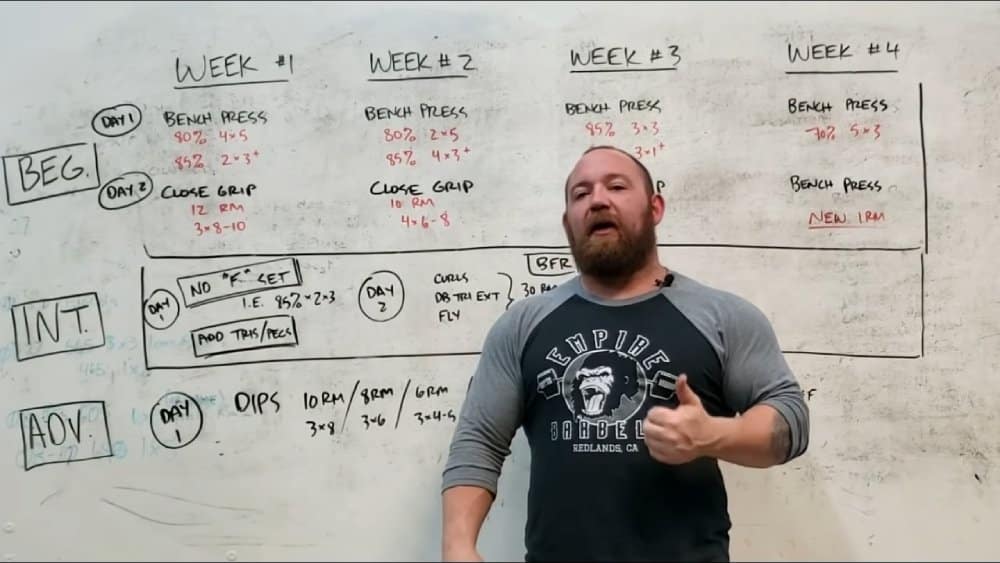Discover the key to optimal bench press frequency in our expert guide, designed to answer the crucial question: “How Often Should You Bench Press?“
Tailored for everyone from beginners to advanced lifters, this article delves into balancing frequency, volume, and intensity, while considering personal factors like age and gender.
You’ll also uncover effective strategies to enhance your routine, prevent injuries, and break through plateaus for peak performance and gains.
Jump to:
Bench Press Frequency And Training Volume

An effective bench press program includes a balance between training frequency, volume, and intensity. Here are some factors to consider while determining your optimal bench press frequency:
- Experience level: Beginners may benefit from a lower frequency (1-2 times per week) to ensure proper recovery and technique learning. More advanced lifters can opt for higher frequency training (2-4 times per week) as their bodies are better accustomed to the exercise.
- Training goals: If your goal is to increase muscle mass, higher volume and moderate training frequency (2-3 times per week) are suitable. For strength gains or powerlifting, focusing on intensity and lower volume with higher frequency (3-4 times per week) may yield better results.
- Recovery: Pay attention to your body’s recovery capacity. Overtraining can lead to potential injuries and performance decrements. Adequate rest, sleep, and nutrition are critical to support your bench press frequency.
- Individual factors: Genetics, age, lifestyle, and stress levels can influence your recovery capability and, subsequently, appropriate training frequency. Listen to your body and adjust the schedule as needed.
Frequency Considerations Based on Experience
Beginner Guidelines
As a beginner, your primary focus should be on learning proper form and getting accustomed to the exercise.
In this phase, it’s generally recommended to bench press two to three times per week, with each session consisting of 3-4 sets of 8-12 repetitions.
This frequency allows you enough practice to improve your technique, while also providing time for recovery and muscle growth. Remember to start with a manageable weight and gradually increase it as you become more comfortable with the exercise.
Intermediate Strategies
For intermediate lifters who have developed a solid foundation in both form and strength, the optimal bench press frequency may be slightly different.
At this stage, you can experiment with different training schedules based on your goals and recovery capacity. Some lifters may prefer to continue bench pressing 2-3 times per week, while others may find benefits in increasing their frequency to 3-4 times per week.
A study concluded that there was no additional benefits of increasing the training frequency from two to four sessions under volume-equated conditions, but it could be favorable to spread the total training volume into several training bouts through the week.
Advanced Lifter Recommendations
For advanced lifters with years of training experience, the frequency of bench pressing becomes even more nuanced.
Your optimal frequency will largely be determined by your individual recovery capabilities, as well as the specific goals you’re working toward.
Some advanced lifters may find success with a higher frequency, such as four to five times per week, for a period to break through plateaus. Meanwhile, others may benefit from periodized programs that modulate volume, intensity, and frequency based on their training objectives.
As an advanced lifter, it’s essential to listen to your body and adjust your bench press frequency accordingly. If you experience difficulty recovering, consider scaling back the volume or intensity to prioritize recovery and avoid overtraining.
Impact of Gender and Age on Bench Press
Differences for Men and Women

Bench press performance can vary between men and women due to differences in muscle mass, strength, and hormonal factors. On average, men tend to have more muscle mass than women and exhibit greater fatigue resistance in strength exercises, such as the bench press and leg press as shown in this study.
However, it’s essential to recognize that individual differences can play a significant role in one’s performance.
For beginners, it’s vital to establish the appropriate starting intensity and gradually progress over time. Inexperienced males and females may need a more guided approach when evaluating their one repetition maximum (1RM) bench press performance, as described in this pilot study.
Adjustments for Different Age Groups
As you age, changes in muscle strength and joint mobility may affect your ability to perform bench presses optimally. To maintain or improve your performance, consider the following adjustments based on age:
- Youth and Adolescents: Building a solid foundation of strength and proper technique is crucial during these developmental years. Young athletes can benefit from focusing on proper form and gradually increasing their resistance. Force-velocity profiling in squat and bench press exercises can provide helpful insights, as mentioned in this study on adolescent rugby players
- Adults: Continued training and regular reassessment of your 1RM can help in adjusting your program to see consistent progress. Prioritize technique, mobility, and specific training goals to maximize your performance at this stage.
- Older Adults: As you age, strength maintenance and injury prevention become more critical. Consider incorporating exercises that target supporting muscle groups, such as upper back and triceps strengthening. Additionally, you may want to switch to lower-impact exercises or modify the bench press to suit your physical capabilities.
Programming Your Bench Press Workout

Optimal Sets and Repetitions
To maximize your bench press gains, it’s important to determine the optimal sets and repetitions for your specific goals.
For muscular strength and endurance, you may want to focus on lower rep ranges, such as 3-5 repetitions per set, with heavier weights.
For hypertrophy (muscle growth), 8-12 reps per set with moderate weights often works best.
In both cases, consider performing 3-5 sets per exercise depending on your training program and goals.
For a balanced and effective bench press workout, try incorporating a mix of rep ranges over time. This can help prevent plateaus and keep your training engaging. Here’s a sample rep and set scheme:
- Strength focus: 4 sets of 4-6 reps, 2-3 minutes rest between sets
- Hypertrophy focus: 3 sets of 8-12 reps, 1-2 minutes rest between sets
Remember that rest intervals play a crucial role in maximizing your bench press performance.
Exercise Variations and Their Roles
Incorporating different bench press variations into your routine can help target various muscle groups more effectively and prevent imbalances. The three main variations are:
- Flat Bench Press: The standard bench press targets the pectoralis major, anterior deltoids, and triceps.
- Incline Bench Press: This variation places more emphasis on the upper pectorals and anterior deltoids.
- Decline Bench Press: A lower angle targets the lower portion of the chest and activates the triceps more.
To make the most of these exercise variations, consider rotating them within your training program. For example, you may want to perform flat bench presses on one session, and then switch to incline or decline variations in the next session. This can help develop a well-balanced chest, shoulders, and triceps.
In addition, using variations like bench press throws can be used for power development in athletes, maximizing mechanical power output during explosive training sessions.
Avoiding and Overcoming Plateaus
Signs of a Bench Press Plateau
A bench press plateau is when you experience little to no progress in increasing your bench press weight or repetitions. Some common signs of a plateau include:
- Stagnant or decreased strength when bench pressing
- Difficulty completing sets at weights you could previously handle
- Lack of muscle growth or definition
Strategies to Break Through Plateaus
To overcome a bench press plateau, consider implementing the following strategies:
- Vary your training routine: Incorporate other chest exercises, such as dumbbell presses or push-ups, to target your pectoral muscles from different angles.
- Adjust volume and intensity: Increase the weight, reduce the number of repetitions, and take longer rest periods between sets. Alternatively, decrease the weight while increasing your repetitions and sets.
- Focus on progressive overload: Ensure that you are consistently challenging your muscles by gradually increasing the weight, repetitions, or sets. This will help your body adapt and grow stronger.
- Use proper form: Ensure that you are correctly executing the bench press with proper form. Incorrect form can limit your progress and even result in injuries.
- Get adequate recovery: Make sure you’re resting adequately between workouts and getting enough sleep. Overtraining can inhibit progress and lead to plateaus.
Applying these strategies to your bench press routine can help you break through plateaus and continue making progress.
Here’s a table summarizing these strategies:
| Strategy | Description |
| Vary your training routine | Incorporate different chest exercises to target your pectoral muscles |
| Adjust volume and intensity | Modify the weight, repetitions, and rest periods |
| Focus on progressive overload | Gradually increase the weight, repetitions, or sets for consistent challenges |
| Use proper form | Make sure to execute the bench press with correct technique |
| Get adequate recovery | Rest sufficiently between workouts and prioritize sleep |
Injury Prevention and Recovery
Common Bench Press Injuries
When bench pressing, you should be aware of common injuries to prevent. Some of these include shoulder and pectoral muscle injuries, wrist strains, and lower back strains. To minimize the risk of these injuries, it’s crucial to practice proper form, adequate warm-ups, and progressive overload.
- Shoulder and pectoral muscle injuries: These injuries often result from a combination of improper form, excessively wide hand placement, or lifting weights that are too heavy for your current capabilities. To prevent these injuries, ensure that your elbows are not flared out significantly and avoid overloading the bar.
- Wrist strains: Strains occur when you grip the bar incorrectly or have a weak wrist. Make sure to position the bar in line with the base of your palms for optimal grip and wrist support.
- Lower back strains: Poor form can result in excessive arching of your lower back, leading to potential lower back injuries. Maintain a neutral spine throughout the movement and engage your core for stabilization.
Recovery Techniques and Practices

To ensure proper recovery and prevent injuries, it’s essential to incorporate specific techniques and practices in your training regimen.
- Proper warm-up: Start with lighter weights to increase blood flow and prepare your muscles for heavier lifts. A thorough warm-up can reduce the risk of injury and improve your overall performance.
- Stretching and mobility exercises: Focus on shoulder and chest stretches, as well as wrist and lower back stretches, to maintain and improve flexibility. Incorporating mobility exercises into your routine is also essential for joint health.
- Adequate rest and recovery: Make sure to give your muscles and joints time to recover. Depending on your experience and goals, bench press frequency can vary from once to three times per week. Avoid overtraining and listen to your body’s needs.
- Progressive overload: Gradually increase the training stimulus (weight, reps, or sets) to promote muscle growth and strength gains while minimizing the risk of injury. Do not make sudden increases in weight, and focus on maintaining proper form.
Parting Thoughts on Training Frequency vs. Volume
In the context of resistance training, training frequency is often a debated factor in maximizing strength gains. The role of frequency is defined as the number of training sessions performed per week per muscle group or exercise.
Meanwhile, total training volume considers the combined factors of sets, repetitions, and intensity of your workouts. Ideally, you should find a balance between these two aspects in your training regimen to achieve the desired results.
Various studies have examined the effects of training frequencies on muscle adaptations on well-trained individuals. However, the optimal frequency remains uncertain. Understanding how frequency and volume interplay with each other can help tailor an effective strength training plan.
The American College of Sports Medicine recommends novice and untrained individuals train every muscle group 2-3 times per week. However, this recommendation has faced criticism due to being based on limited evidence. Despite the increasing number of studies surrounding training frequency, a common consensus has not been reached.
In conclusion, it’s essential to pay attention to both frequency and volume in your resistance training program, as optimal results will vary depending on individual factors, such as training experience and personal goals. Experiment with different training schedules and monitor your progress to find the ideal balance between frequency and volume for your individual needs.
References and Footnotes
- https://journals.lww.com/nsca-jscr/fulltext/2015/07000/influence_of_resistance_training_frequency_on.8.aspx
- https://peerj.com/articles/10781/
- https://journals.lww.com/nsca-jscr/abstract/2006/05000/THE_EFFECT_OF_REST_INTERVAL_LENGTH_ON_BENCH_PRESS.27.aspx
- https://journals.lww.com/nsca-jscr/abstract/2001/02000/the_load_that_maximizes_the_average_mechanical.4.aspx
- https://journals.lww.com/nsca-jscr/Fulltext/2015/07000/Influence_of_Resistance_Training_Frequency_on.8.aspx
- https://link.springer.com/article/10.1007/s42978-023-00236-x
- https://journals.lww.com/nsca-jscr/Abstract/2005/05000/Training_Leading_To_Repetition_Failure_Enhances.24.aspx
- https://www.ingentaconnect.com/content/wk/jsc/2022/00000036/00000001/art00002
- https://journals.lww.com/nsca-jscr/Fulltext/2015/07000/Influence_of_Resistance_Training_Frequency_on.8.aspx
- https://peerj.com/articles/10781/














